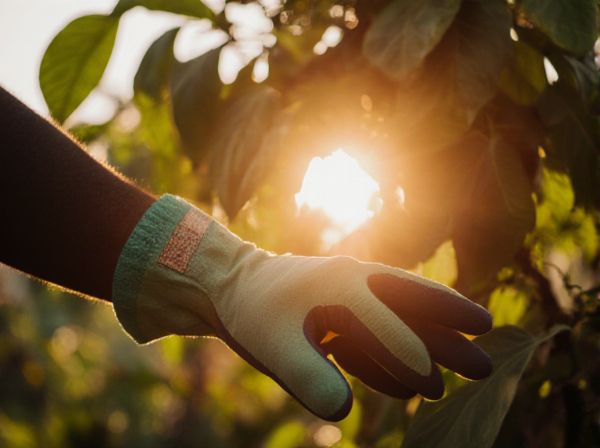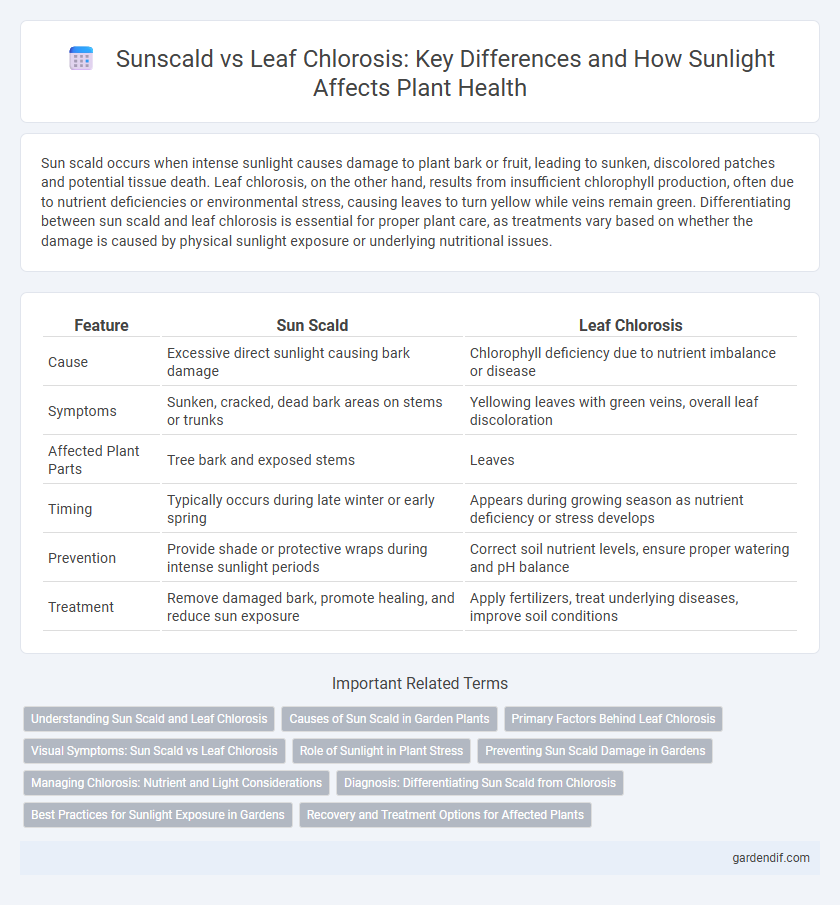
Sun Scald vs Leaf Chlorosis Illustration
Sun scald occurs when intense sunlight causes damage to plant bark or fruit, leading to sunken, discolored patches and potential tissue death. Leaf chlorosis, on the other hand, results from insufficient chlorophyll production, often due to nutrient deficiencies or environmental stress, causing leaves to turn yellow while veins remain green. Differentiating between sun scald and leaf chlorosis is essential for proper plant care, as treatments vary based on whether the damage is caused by physical sunlight exposure or underlying nutritional issues.
Table of Comparison
| Feature | Sun Scald | Leaf Chlorosis |
|---|---|---|
| Cause | Excessive direct sunlight causing bark damage | Chlorophyll deficiency due to nutrient imbalance or disease |
| Symptoms | Sunken, cracked, dead bark areas on stems or trunks | Yellowing leaves with green veins, overall leaf discoloration |
| Affected Plant Parts | Tree bark and exposed stems | Leaves |
| Timing | Typically occurs during late winter or early spring | Appears during growing season as nutrient deficiency or stress develops |
| Prevention | Provide shade or protective wraps during intense sunlight periods | Correct soil nutrient levels, ensure proper watering and pH balance |
| Treatment | Remove damaged bark, promote healing, and reduce sun exposure | Apply fertilizers, treat underlying diseases, improve soil conditions |
Understanding Sun Scald and Leaf Chlorosis
Sun scald occurs when plant tissues are damaged by intense sunlight, causing browning and necrosis, particularly on exposed stems and fruits. Leaf chlorosis results from a lack of chlorophyll, leading to yellowing leaves due to nutrient deficiencies, water stress, or disease rather than direct sun exposure. Distinguishing these conditions relies on observing tissue damage patterns and understanding the underlying causes related to light intensity and plant health.
Causes of Sun Scald in Garden Plants
Sun scald in garden plants is primarily caused by sudden exposure to intense sunlight, particularly on bark or fruit surfaces that were previously shaded or insulated, leading to tissue damage and sunburn. Rapid temperature fluctuations, especially during winter or early spring, exacerbate sun scald by causing cell rupture in the exposed areas. Lack of protective foliage and inadequate moisture levels further increase the vulnerability of plants to sun scald compared to leaf chlorosis, which is primarily linked to nutrient deficiencies and stress factors.
Primary Factors Behind Leaf Chlorosis
Leaf chlorosis, characterized by yellowing leaves, primarily results from nutrient deficiencies, particularly iron, magnesium, and nitrogen, which disrupt chlorophyll synthesis. Environmental stressors such as inadequate sunlight, poor soil drainage, and pH imbalances intensify chlorophyll degradation, leading to chlorosis symptoms. Unlike sun scald, which causes physical tissue damage from intense sunlight exposure, leaf chlorosis stems from physiological disruptions affecting leaf pigment production.
Visual Symptoms: Sun Scald vs Leaf Chlorosis
Sun scald presents as bleached, white or tan patches on fruit or bark, often with a rough texture and potential sunken areas, indicating damage from intense sunlight exposure. Leaf chlorosis is characterized by yellowing of leaf tissue between veins while veins remain green, signaling impaired chlorophyll production due to nutrient deficiencies or environmental stress. Differentiating these visual symptoms is crucial for accurate diagnosis and effective treatment of sunlight-related plant damage.
Role of Sunlight in Plant Stress
Sun scald occurs when intense sunlight causes localized damage to plant tissues, especially on bark or fruit surfaces, leading to cell death and increased vulnerability to pathogens. Leaf chlorosis, on the other hand, results from sunlight-induced stress impairing chlorophyll production or function, causing yellowing leaves and reduced photosynthesis. Both conditions underscore sunlight's dual role in plant stress by driving essential energy processes while risking oxidative damage under excessive exposure.
Preventing Sun Scald Damage in Gardens
Sun scald damage in gardens occurs when intense sunlight causes bark or fruit tissue to overheat, leading to cracking and tissue death, particularly on thin-barked trees and young plants. Preventing sun scald involves using protective wraps or tree guards, planting shade trees, and maintaining healthy foliage to provide natural shading. Leaf chlorosis, on the other hand, results from nutrient deficiencies or poor soil conditions and is not directly caused by sunlight exposure, making the prevention strategies different from those used for sun scald.
Managing Chlorosis: Nutrient and Light Considerations
Managing leaf chlorosis involves optimizing nutrient availability, particularly iron and magnesium, to ensure proper chlorophyll synthesis and prevent yellowing caused by deficiencies. Regulating sunlight exposure is essential, as excessive direct sun can exacerbate chlorosis symptoms, while insufficient light reduces photosynthetic efficiency. Balancing nutrient supplementation with controlled light conditions supports healthy foliage and minimizes the risk of sun scald and chlorosis-related damage.
Diagnosis: Differentiating Sun Scald from Chlorosis
Sun scald presents as localized, sun-exposed bark or fruit tissue damage, characterized by sunken, discolored areas often accompanied by cracking, while leaf chlorosis manifests as uniform yellowing of leaves due to nutrient deficiencies or water stress. Diagnosis involves examining the affected plant parts; sun scald damage typically occurs on the south or southwest sides where sunlight is intense, whereas chlorosis affects the entire leaf surface with interveinal yellowing. Accurate diagnosis requires assessing symptom patterns, exposure locations, and testing soil nutrient levels to distinguish between physical sun damage and physiological nutrient imbalance.
Best Practices for Sunlight Exposure in Gardens
Sun scald causes damaged, sunburned bark on exposed stems and branches, often appearing as blistered or cracked areas, while leaf chlorosis results in yellowing leaves due to insufficient chlorophyll from factors like nutrient deficiencies or overexposure to sunlight. Best practices for sunlight exposure in gardens include providing partial shade during peak sunlight hours, using shade cloths to prevent intense direct sun, and selecting plant varieties adapted to the garden's light conditions. Regular monitoring of plant health and adjusting exposure based on species-specific sunlight tolerance optimizes growth and minimizes risks of both sun scald and leaf chlorosis.
Recovery and Treatment Options for Affected Plants
Sun scald causes damaged bark and sunken lesions primarily on trunk and branches, requiring protective wraps and shading to aid recovery, while treatment for leaf chlorosis focuses on correcting nutrient deficiencies, especially iron or magnesium, through foliar sprays or soil amendments. Recovery from sun scald involves minimizing further sun exposure and preventing secondary infections by pruning damaged tissue, whereas leaf chlorosis treatment prioritizes improving soil pH to enhance nutrient uptake and applying appropriate fertilizers. Both conditions benefit from ensuring proper watering and overall plant health maintenance to promote resilience and new growth.
Sun Scald vs Leaf Chlorosis Infographic

 gardendif.com
gardendif.com